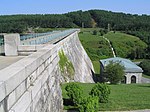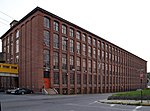Wachusett Aqueduct
Aqueducts in MassachusettsAqueducts in Middlesex County, MassachusettsAqueducts on the National Register of Historic PlacesBuildings and structures in Marlborough, MassachusettsHistoric districts in Middlesex County, Massachusetts ... and 6 more
Historic districts in Worcester County, MassachusettsNRHP infobox with nocatNational Register of Historic Places in Middlesex County, MassachusettsNational Register of Historic Places in Worcester County, MassachusettsTransportation buildings and structures in Worcester County, MassachusettsTransportation buildings and structures on the National Register of Historic Places in Massachusetts

The Wachusett Aqueduct is a secondary aqueduct that carries water from the Wachusett Reservoir to the John J. Carroll Water Treatment Plant at Walnut Hill in Marlborough, Massachusetts. It is part of the public water supply system for the communities of Greater Boston that are served by the Massachusetts Water Resources Authority (MWRA), which manages the aqueduct. The aqueduct serves as a standby backup to the Cosgrove Tunnel.
Excerpt from the Wikipedia article Wachusett Aqueduct (License: CC BY-SA 3.0, Authors, Images).Wachusett Aqueduct
Boylston Street,
Geographical coordinates (GPS) Address Nearby Places Show on map
Geographical coordinates (GPS)
| Latitude | Longitude |
|---|---|
| N 42.399166666667 ° | E -71.689444444444 ° |
Address
Boylston Street 301
01510
Massachusetts, United States
Open on Google Maps









